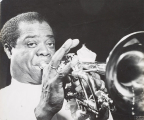Tulsa and Oklahoma have a rich history and tradition of jazz music, so it’s only fitting that Gilcrease should celebrate this uniquely American form of music with a special exhibition that opens summer of 2015.
On 52nd Street: The Jazz Photography of William P. Gottlieb opens July 25 and runs through October 11, 2015.
In New York City, 52nd Street was the epicenter of a music and social revolution during the 1940s. Known as “Swing Alley,” or simply “The Street,” it was “heaven on earth for jazz fans and jazz musicians,” photographer William P. Gottlieb (1917–2006) recalled. In the dozen or so nightclubs that located there — mostly in the converted basements of former speakeasies — jazz emerged as distinct concert music with featured soloists.
No longer simply dance music, jazz as exemplified by the burgeoning bebop tradition became to Gottlieb a “rebellion against the rigidities of the old order.” “The Street” was also one of the few racially integrated places in the city. As trumpeter Dizzy Gillespie remembered, there was “very little racist feeling,” though “once you left Fifty-Second Street, look out.”
Born in Brooklyn, Gottlieb began photographing jazz musicians in 1938 to illustrate a weekly feature, “Swing Sessions,” that he wrote for The Washington Post. Over the next decade he created almost 2,000 portraits of more than 250 musicians.
At this time he also had a regular jazz program at WRC Radio and served as an assistant editor for Down Beat magazine. Gottlieb’s photographs are notable for their artistic originality and the intimate relationship he formed with many of his subjects.
Though he traveled widely to photograph, he spent the majority of his time on 52nd Street following the end of World War II. These remarkable photographs recall the leading jazz musicians of this era and document changing social mores in American life.


